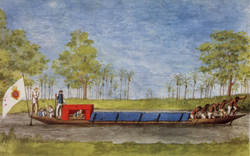Alexandre Rodrigues Ferreira
| Alexandre Rodrigues Ferreira | |
|---|---|

"Philosophical Voyage" of Alexandre Rodrigues Ferreira, ca.1792
|
|
| Born | April 27, 1756 Bahia, Brazil |
| Died |
April 23, 1815 (aged 58) Lisbon, Kingdom of Portugal |
| Residence | Brazil, Portugal |
| Nationality | Portuguese |
| Fields | natural scientist, explorer |
| Institutions |
University of Coimbra Museum of Ajuda Royal Cabinet of Natural History |
| Alma mater | University of Coimbra |
| Known for | Expedition to the interior of Brazil |
Alexandre Rodrigues Ferreira (April 27, 1756 – April 23, 1815) was a naturalist born in the Portuguese colony of Brazil. He undertook an extensive journey which crossed the interior of the Amazon Basin to Mato Grosso, between 1783 and 1792. During this journey, he described the agriculture, flora, fauna, and native inhabitants. Because of the energy and skill that he devoted to his explorations, he became known as the "Brazilian Humboldt".
Born in Bahia (present day Salvador), the son of the merchant Manuel Rodrigues Ferreira, Ferreira began his studies at the Convent of Mercês, in Bahia, which gave him his first orders in 1768.
He then studied law and then natural philosophy and mathematics at the University of Coimbra, where he received his baccalaureate at age 22. He continued his studies at the institution, where he studied natural history, and obtained his doctorate in 1779.
He then worked at the Royal Museum of Ajuda. On March 22, 1780 he was admitted as a corresponding member of the Portuguese Royal Academy of Sciences.
At this time the colonial economy of Brazil was in a state of decadence, having exhausted the placer gold of Mato Grosso, Goiás, and, especially, Minas Gerais. For this reason, the queen Maria I of Portugal, desiring to know more about the central and north of the Brazilian colony, which at that point remained practically unexplored, in order to implement developmental measures, ordered Alexandre Rodrigues Ferreira, as a naturalist, to undertake a "philosophical voyage through the captaincies of Grão-Pará, Rio Negro, Mato Grosso e Cuiabá." The idea was to provide an impetus for economic exploration and enable conquest of disputed territory.
In 1783 the naturalist left his post at the Museum of Ajuda, and, in September, left for Brazil to describe, collect, prepare and remit to the Royal Museum of Lisbon samples of tools used by the local population, as well as local minerals, plants, and animals. He was also to write political and philosophical commentaries about what he saw in the places he passed through. This pragmatism was what separated this voyage from other, more scientific, voyages led by other naturalists who explored America.
...
Wikipedia
